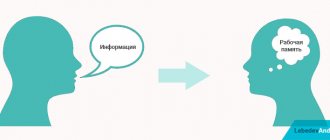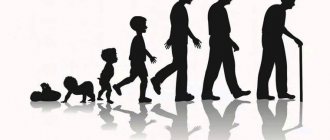Psychologists define the cognitive sphere as a set of mental processes designed to perform the function of rational cognition. This term was introduced in the 60s of the last century. Then, in the wake of the large-scale development of cybernetics and the widespread passion for this science, the comparison of a person with a complex biocomputer became popular. Attempts have been made to model human psychological processes with varying degrees of success.
The cognitive sphere is something that can be modeled. The area with which this technique did not work was called affective.
The concept and essence of the cognitive sphere
Today in psychological practice, by the phrase “cognitive sphere of personality,” experts understand several psychological processes that occur in accordance with a logical and meaningful sequence, the purpose of which is to process information.
That is, we can talk about this area only if data processing is characterized by logic and rationality.
Traditionally, this area is associated with memory, attention, perception, understanding, thinking, decision-making, action and influence (however, only when it concerns cognitive processes and not entertainment or attraction). With a certain simplification, it can be argued that the cognitive sphere is a set of competence and knowledge, skills and abilities.
Learn more about rational and emotional mechanisms of perception
The cognitive sphere is a kind of synonym for rational perception, which manifests itself as a critical, analytical assessment.
The direct opposite of the rational type of knowledge is intuition, that is, a pure, living impression. Any term becomes more understandable when the definition is supported by illustrations: despite the fact that ice cream is delicious and you really want to buy it, a person does not eat these sweets on the street in winter, as he may get sick. This conclusion is the result of rational reflection.
When the rational mechanism of understanding is activated, it involves concepts and logic. While emotional, bodily and experiential ways of understanding involve empathy, empathy and sensitivity.
Therefore, in order to exert a rational influence, they use various methods of persuasion and explanation (referring to reason and logic). Irrational methods are used for suggestion, emotional contagion, anchoring and other techniques.
What does the term "cognitive function" mean?
Having discussed how the human brain works, we can move on to the question of what cognitive functions are. This term is used to describe the mental processes through which a person gains the ability to perceive, transmit, analyze and remember various information. Thanks to these processes, a person gets the opportunity to interact with the world around him.
The human brain is active every day. Cooking breakfast, reading books, driving and making small talk are carried out thanks to billions of complex calculations. Connections between neurons in different areas of the brain allow a person to establish contact with his environment . Thus, cognitive functions are responsible for communication contact not only between people, but also surrounding objects.
Quite often, when talking about higher cognitive functions, cognitive skills are mentioned, the purpose of which lies in interaction with the outside world. Although each of these skills is considered separately, most of them have strong relationships and various overlaps. Cognitive functions of the human brain include:
- Attention is a rather complex process that covers many thought processes. It is difficult to give attention a clear and concise description and include it in a specific anatomical structure. Speaking figuratively, attention is a cognitive function with the help of which a person, among external (smells, sounds and images), as well as internal (thoughts and emotions) stimuli, selects those that will be useful in order to implement mental or motor activity. It is this formulation that allows us to most accurately characterize all the complex processes that are involved in the work of other higher functions.
- Memory is one of the most complex processes by which received information is encoded, stored and reproduced. The performance of this system plays a fairly significant role in everyday life. This skill is closely intertwined with attention, since without it it is impossible to obtain complete information.
- Executive processes are another complex higher-order system. There are a sufficient number of different definitions for this term, but most of them are characterized by the control of cognition and regulation of the way of thinking, through the use of various processes that have little correlation. Executive processes are a collection of various abilities, among which we should highlight directed attention, elements of planning and programming, as well as the regulation of intentional behavior. The prefrontal cortex is responsible for executive functions.
- Speech is a communication system through which communication between people occurs. Among the main functions of speech, in addition to establishing contact with people around us, we should highlight the construction of a competent structure of thinking. During speech processing, different parts of the brain are activated. The main interaction of various functional systems is observed in the left hemisphere of the brain. Speech processing involves two cortical areas of the left hemisphere, which are responsible for the reception and expression of speech.
- Visual Perception - This set of higher skills includes functions that help a person to distinguish and recognize different stimuli. This set of skills allows you to categorize various objects and remember them. A properly constructed and adjusted system of visual perception allows a person to remember people’s faces, and gives the opportunity to find the differences between a screwdriver and a dress.
Cognitive functions are abilities that connect us with the world around us and allow us to form an idea of it
Each of the above skills includes several subgroups that are closely interrelated.
Interaction and interdependence of the two spheres
Considering that each personality has integrity, its main spheres (emotional, cognitive) perform their specific functions, complementing each other.
In everyday life, most people get used to making do with feelings and established habits; they trust automatisms. However, if necessary, rational thinking with its logic and concepts is activated.
Scientists are still studying the development of the cognitive, emotional sphere and the features of their functioning. As for rational methods of cognition, science has advanced quite far in their classification and description.
Affective processes are extremely difficult to model due to their unpredictability. These include emotions that accompany a sensual attitude towards life, interaction with the world, with oneself and society. True, there are a number of mental processes, the occurrence of which is regulated by specific laws. Then they talk about studying the cognitive component of these emotions.
The relationship between emotional and cognitive
A mentally developed person is a holistic personality in which both spheres, cognitive (rational) and affective (emotional), coexist. Each of them performs its functions, complementing each other .
Most people in everyday life are guided by emotional, sensual impulses, however, in a certain situation (for example, when performing their job duties) they also activate the rational side of their personality.
The relationship between the emotional and cognitive spheres lies in the fact that even when performing any rational actions, a person does not cease to feel , and when certain emotional impulses arise, in most cases he logically comprehends his actions and the consequences that they may entail.
About emotional-volitional mental processes in this lecture:
Characteristics and definition of memory
Memory is the human ability to preserve and accumulate information about the world around us. If this mechanism did not exist, people would constantly have to perceive all events and phenomena as if they were happening for the first time. Memory allows you to reduce the energy costs of the brain to evaluate constant or repetitive factors, as well as adapt to circumstances with minimal stress.
Thus, memory is responsible for the fact that a person stores, remembers and then, if necessary, reproduces his individual experiences.
Various brain activity disorders
Impairment of cognitive functions can have varying degrees of severity. There are a number of specific factors that lead to changes in brain activity. Such factors include traumatic brain injuries, infectious diseases and cancer. In addition, cardiovascular pathologies such as atherosclerosis, stroke and heart attack have a certain impact on brain function.
Degenerative diseases such as Parkinson's or Alzheimer's disease play an important role in the issue of cognitive impairment. The development of various disorders in the functioning of the brain is facilitated by problems with metabolism and the functionality of the immune system.
Quite often, the type of violation depends on the form of exposure to certain factors. Some skills can be fully restored with the right approach to treating the disease. However, the effectiveness of treatment directly depends on the timeliness of seeking medical help.
Memory types
Depending on which parts of the brain and organs of the human body are involved in the process of memorization, there are:
- Motor memory - automatic movements. She is responsible for developing useful skills that are used quite often. The purpose of this mechanism is to increase efficiency and speed up motor processes. People use motor memory to drive cars, write words, play musical instruments, and even walk.
- The emotional type of memory is the memorization of emotional states accompanying certain situations. This mechanism is designed to complement other types of memory. The retention of emotions and reactions allows a person to strive for certain events and avoid others.
- Figurative memory, in which data on visual, auditory, gustatory, olfactory and other images is stored. This type of memory is considered professional, since the intensity of its development depends on human activity.
- Verbal-logical, the object of which is thoughts. It is carried out thanks to the presence of words.
- Voluntary and involuntary memory. Their difference is that while storing information, a person can understand why he needs this information, or remember it in random order.
- Short-term, operational and long-term memory. The first ensures the storage of information literally in a fraction of a second, the second provides access to intermediate results in the course of solving current problems, and the last represents the accumulation of data for the future.
The listed types of memory, as features of the cognitive sphere, function in close interrelation with each other.
Cognitive sphere of personality
Scientists from all over the world have at different times asked questions about the nature of intelligence. One of the most important questions is: what kind of person can be called smart? The answer has still not been found. But if we are closer to it, then it lies in the cognitive sphere of the individual.
The cognitive sphere of personality is a cognitive sphere that includes such cognitive processes as:
- Mnemonic processes: memory. In particular – preservation, memorization, forgetting, reproduction. Their main function is to store information in memory.
- Perceptual processes: perception, sensations, attention. Their main function is to receive information from the internal and external environment.
- Intellectual processes: imagination, thinking, speech. Their main function is to generate information, fill gaps in information and exchange it.
Many cognitive psychologists believe that the most important cognitive processes are memory, imagination, and attention.
Memory . Plays a key role in the cognitive sphere of the individual, one might say decisive. It is a fundamental component of intelligence and its functions are much broader than simply “remember as much as possible.”
There are several types of memory. Here are some of them (according to content criteria):
- Emotional memory is a memory for an emotional state that arises in all situations without exception. To some extent, it complements all other types of memory.
- Motor memory is memory for movements. If a person has developed motor memory, he has dexterity in work, physical dexterity, and masters activities that require coordination of movements.
- Verbal-logical memory is memory for thoughts that are formed using words.
- Figurative memory – memory for auditory, figurative, olfactory, gustatory and other images. Well developed among artists, architects, writers and scientists.
According to the criterion of time, there are short-term, long-term, working and intermediate memory.
It should be said that all types of memory cannot be considered separately; they are interconnected to one degree or another.
Imagination . A person can imagine something that does not exist, and also plan based on a chain of interconnected thoughts. This is possible thanks to imagination.
Imagination helps a person to imagine the final result of his work and, no less important, its intermediate results. In this regard, it is worth noting that, despite the fact that imagination is considered a tool of representatives of imaginative professions, in fact this skill is vital for every person.
The functions of imagination are:
- management of physiological states;
- creation and implementation of an internal action plan;
- voluntary regulation of cognitive processes;
- management of emotional and need states;
- activation of visual-figurative thinking.
By type, imagination can be active or passive. During an active period, a person imagines the transformation of the world around him and plans to achieve his goal. By passive we mean dreams and dreams that do not come true.
Attention . This is a certain orientation of the mind that allows you to select something specific from a huge number of stimuli. Sensors allow a person to absorb stimuli from the environment and thereby consciously decide what to pay attention to.
Attention can be voluntary (when we consciously direct it using volitional effort) and involuntary (it occurs without volitional effort and is controlled by random factors).
Basic properties of attention:
- Focus (concentration) is the extent to which you can focus on some objects and ignore others.
- Resilience is how long you can focus on certain objects.
- Distribution is the extent to which you are able to hold several heterogeneous objects in your mind.
- Volume is the number of objects to which you can direct your attention with equal clarity and distinctness.
- Switchability is how quickly you can switch your attention from one object to another.
It should be said that in one area or another, cognitive abilities are also developed in animals. The more developed the organism, the more developed their cognitive sphere.
For example, earthworms are primitive organisms because they only have sensations. Whereas the frogs that eat them have developed perception. And herons that eat frogs have not only perception, but also thinking and memory. If we talk about the smartest birds, crows are considered to be the smartest birds. But among the animals there are primates.
In the human world the situation is somewhat different. The cognitive sphere of personality is formed in everyone, but specific people develop abilities in different ways. Hence the difficulties in answering the question about intelligence and the role of the development of cognitive processes in achieving success in life.
But there are obvious conclusions. If a person has a developed cognitive sphere, he:
- It perceives incoming information better, so it is better oriented in what is happening.
- Processes incoming information better and faster: throws out the unimportant and accepts the important. This allows him to work with the right material.
- He remembers information better: this means that he quickly extracts the necessary arguments and operates with them, and is able to retain complex diagrams and concepts in his head.
- Draws correct conclusions: If he knows how to sift the wheat from the chaff, remember complex concepts and has a good memory, then there is a possibility that he will draw the right conclusion and make an intelligent decision.
It should also be said that cognition is not a passive process. In order to perceive and process information, you need to pay conscious attention to it and make an intellectual effort.
Diagnostics of the cognitive sphere
There are (including on the Internet) many tests that, to one degree or another, promise to show the level of development of a person’s cognitive sphere. Here are some famous ones.
Diagnosis of attention:
- Munstenberg technique;
- “Proofreading test” technique;
- Landolt rings.
Memory diagnostics:
- A test to memorize ten words (ten words selected in such a way that no connection could be established between them).
- Wechsler subtest.
- Associative memory test (ten pairs of homogeneous words are read out, between which semantic connections are easily established. Then the first word of each pair is read out, and the subject names the second word).
Diagnostics of imagination:
- Toulouse-Pieron test.
- Torrance test.
- Test “Artist – Thinker”.
Using these tests, you can get a rough impression of each aspect of the cognitive domain.
Cognitive sphere of personality in a child
The first person to question cognitive development was Jean Piaget. He wrote a lot about the fact that a person must develop imagination, logic, perception, memory and other cognitive processes.
According to Piaget, a prerequisite for the emergence of speech in a child is the development of sensorimotor intelligence. His theory was constructivist, that is, it argued that a person can develop cognitive abilities through conscious actions in the environment. At the same time, Piaget insisted that children do not think like adults.
This is especially important for preschoolers. At this age, the intellectual foundation is laid. At the same time, mastering figurative forms of cognition will help the child understand the objective laws of logic and master complex concepts.
Research in the field of the cognitive sphere of a child’s personality was once carried out by S. L. Rubinshtein, L. S. Vygotsky, A. A. Leontyev, A. M. Shakhnarovich, F. A. Sokhin. If we summarize their views, we can deduce the following points:
- Speech and language are a kind of “knot” into which various lines of mental development are woven: imagination, memory, thinking, emotions and more.
- The child’s speech develops in the course of generalization of linguistic phenomena, his own speech activity and the perception of adult speech.
- The main task in teaching a language is the formation of linguistic generalizations and elementary awareness of the phenomena of language and speech.
- It is necessary to develop three functions of speech in a child: communicative, cognitive and regulatory.
Children, like adults, can also have their abilities assessed. With the help of tests, the reasons for school failure and the success of intellectual development are determined, for example. A conclusion can also be made about the need for correction of mental development.
Did you like the article? Join our communities on social networks or our Telegram channel and don’t miss the release of new useful materials: TelegramVKontakteFacebook
We also recommend reading:
- Storytelling
- Visuospatial Corsi test: description and application
- Mental processes: types and brief description
- Spheres of personality
- Types of memory and their features
- Cognitive load theory
- Intelligence and its development: several recommendations
- Cognitive psychology and cognitive psychotherapy
- Cognitive processes
- Exercises for memory development in preschoolers
- Two important laws of memory
Key words:_D1025, 1Cognitive sciences, 4Cognitive sciences
Imagination is a truly human ability
One of the most important differences in the activities of humans and animals is that people project (imagine) the end result of their actions before doing anything. This happens thanks to such an ability as imagination. It provides people with the ability to create an image of an object that does not exist in the real world, hold it, and even moreover, manipulate it.
The development of the cognitive sphere in general and imagination in particular is important for generating solutions in the absence of complete information. With the ability to design theoretical models, people can not only imagine the final result of actions, but also “see” the intermediate products.
Structure and meaning
The significance of the cognitive sphere is the ability to perceive, remember, process new information and apply the acquired knowledge in one or another area of one’s life.
That is, this is the ability to learn and practically apply certain skills.
The cognitive sphere includes various components, such as:
- attention;
- memory;
- imagination.
Moreover, each of these components includes different types of thought processes .
Each of these cognitive functions has its own definition, functions and varieties.
Attention
Attention is a person’s ability to select the information he needs (identify what is important, while eliminating unnecessary), and focus on it.
This function is fundamental , because without attention, no new information or knowledge can be obtained, assimilated and processed.
Depending on how much effort it requires from a person to turn on and maintain attention, this function is divided into several types:
- Involuntary . Does not require any effort from a person. Occurs when a random object or information becomes the object of attention (for example, bright signs in stores).
- Arbitrary . To maintain attention, a certain amount of effort is required from a person to concentrate on the chosen object and filter out all distractions (for example, when studying a new topic in class).
- Post-voluntary . It is considered as a consequence of voluntary attention, which is maintained at a conscious level (for example, when studying a topic in more depth).
Attention has certain characteristics, such as:
- Stability , that is, the ability to hold attention on a particular object for a long time. In some cases, a person experiences attention when he is distracted from an object for a while, but then returns to it again.
- The degree of concentration , that is, the level of focus on the object of attention.
- Volume , that is, the amount of information on which a person can simultaneously maintain his attention.
- Distribution , that is, a person’s ability to pay attention to several different objects at the same time.
- Switchability , that is, the ability to quickly move from one type of activity that requires attention to another.
You can learn about what cognitive dissonance is from our article.
Memory
Memory is the ability to retain and accumulate information received about certain objects, their properties, and, in general, about the world around us as a whole.
Memory is necessary for a person, because in its absence, each time one would have to re-learn the information received, which would make the learning process impossible.
There are the following types of memory, such as:
- Motor , in which a person remembers on a subconscious level a particular sequence of movements (for example, when performing monotonous physical work).
- Emotional . In the case when a person remembers certain emotions that arose in him in a similar situation.
- Figurative . Associated with remembering specific images, sounds, smells. This type of memory is most developed in people of creative professions, for example, artists.
- Short-term and long-term memory, when the information received is remembered for only a few seconds or for a long period of time.
- Voluntary and involuntary . Voluntary memory requires effort from a person when he needs to remember this or that information that is important to him. Involuntary memory occurs when information is “stored in the head” regardless of a person’s desire.
Imagination
Imagination is considered to be a person’s ability to imagine the final goal, the result of his actions even before the moment these actions began to be implemented.
Imagination gives people the opportunity to create in their thoughts those objects that do not exist in the real world.
And with certain visualization skills, a person can hold a given object in his thoughts for a long time and use it in his imagination.
There are such types of imagination as:
- Active , when a person carries out any creative activity aimed at transforming the world around him. At the same time, the converter itself clearly understands the final result of its actions.
- Passive imagination, which represents images that are far from everyday reality, fantastic pictures, dreams.
- Deliberate imagination, when a person, while performing any action, consciously tries to imagine their consequences.
- Unintentional . Occurs, for example, in a half-asleep state, in a dream, in a state of drug intoxication (hallucinations). A person is unable to control the images and thoughts that arise in his head.
How does imagination work? Psychology lesson in this video:
Types of imagination and their characteristics
The main parameters that describe imagination are activity and effectiveness.
Often it acts as an integral element of creative activity, that is, it participates in the transformation of the surrounding reality. This is active imagination.
In contrast, there is a passive type, which is characterized by unrealistic or impracticable projects. People who want to escape from reality resort to passive imagination. They can create images and outline behavior programs that can never be implemented.
Unintentional imagination is activated at the moment of weakening control over consciousness (dreams, hallucinations).
Attention and its varieties
Characteristics of the cognitive sphere would be incomplete without a description of such a phenomenon as attention. It accompanies almost all types of human activity: it ensures clear and effective perception, memory or thinking.
The main task of attention is that it selects and limits current stimuli. It also ensures focus and concentration of mental activity. In other words, it helps the subject to focus on the object.
There are several types of attention:
- Involuntary. It is the simplest and most natural, as it appears without effort on the part of a person.
- Arbitrary. It requires the manifestation of will to concentrate on the chosen goal, as well as to repress interfering thoughts and impulses.
- Post-voluntary. Its peculiarity is that it is a consequence of voluntary attention, but is maintained consciously.
As a rule, the post-voluntary type is caused by a deep and persistent interest in what is happening and what will be obtained as a result.
Like different types of memory, types of attention are usually tightly interconnected; they can move and flow into each other.
Cognitive development of preschoolers card index
Development of cognitive processes in a preschooler.
What is this “cognitive development” and why is it so important to play with children?! Cognitive development, that is, the formation and development of a person’s cognitive sphere, namely his perception, memory, thinking, speech, imagination, attention.
When asking these questions, it is important not to miss the most important thing: the child’s psyche develops in play, each mental process is inseparable from the general development of the child. Let's take a closer look.
Thinking is a mental process of reflecting reality, the highest form of human creative activity. This is a creative transformation of their subjective images in the human mind, their meaning and meaning to resolve real contradictions in the circumstances of people’s life, to form new goals, discover new means and plans for achieving them, revealing the essence of the objective forces of nature and society.
Thinking as the purposeful use, development and increase of knowledge is possible only if it is aimed at resolving contradictions that are objectively inherent in the real subject of thought. In the genesis of thinking, the most important role is played by people’s understanding of each other, the means and objects of their joint activities.
It is thinking that plays a special role, and it is consistently formed as follows:
- visually effective;
- visually figurative;
-verbal-logical.
As a result, we are able to analyze, synthesize information, generalize, compare, specify and abstract.
Games for developing thinking:
We offer you several games to develop this important component of the psyche.
Game 1: “Edible-Inedible” - this game is familiar to many of us since childhood. The rules are simple, and the benefits are difficult to overestimate. An adult offers the child any object, and the child must classify it as edible or inedible (can be combined with throwing a ball, thereby overcoming physical inactivity);
Game 2: “Housewarming party at the nesting dolls” (develops systematization skills).
The nesting dolls settled in a new house, each got their own apartment: the smallest on the first floor, a little larger on the second, even larger on the third, even larger on the fourth, and the largest on the fifth. They were happy and went for a walk in the park. In the evening they came and forgot who lived where. Help the nesting doll find their apartments, tell us who lives where?
Game 3: “Match a word.”
The adult throws the ball to the child and names the category (for example, toy). The child’s task is to choose a pair for this category (for example, a toy - a car). Then the players change roles.
Game 4: “The 4th extra.”
This game can also be played without using any special aids. An adult names four objects, one of which is redundant. The child needs to identify the extra item and explain his choice. Children's logic can be incredible!
Game 5: “Create a riddle”
The driver comes up with a riddle about some object, describing the mystery in words. The rest of the participants need to guess.
There are a great many thinking games and they are limited only by your imagination.
Memory is the remembering, preservation and subsequent reproduction by an individual of his experience. The physiological basis of memory is the formation, preservation and updating of temporary connections in the brain. Temporary connections and their systems are formed when the action of stimuli on the sense organs is adjacent in time and when the individual has orientation, attention, and interest in these stimuli.
In older preschool age (5 and 6 years old), a transition occurs from involuntary memory to the initial stages of voluntary memorization and recall. At the same time, there is a differentiation of a special kind of actions that correspond to the goals: remember, recall, which are set for children. The child’s active identification and awareness of mnemonic goals (that is, memorization goals) occurs in the presence of appropriate motives; the memorization process is formed by the end of preschool age, i.e., at the age of 6–7 years. It is characterized by attempts to form mental logical connections between memorized words. The existence of such connections is, first of all, indicated by the very nature of reproduction. During reproduction, the child changes the order of the objects named to him and combines them according to their purpose. Initially, the methods of memorization, as well as the methods of recall, are very primitive and not yet specialized enough. The child takes them from those actions that he already owns. These are methods such as, for example, repeating an order after an adult or returning a child in the process of remembering to the links he has already reproduced.
Memory development games:
Train your memory!
Game 1: “Snowball” - development of auditory mechanical memory. Any number of household members can participate. The first one names a word, the next one repeats it and names his own, etc. To make the task easier, you can take a separate topic and/or name each next word starting with the last letter of the previous one.
Game 2: “Smells and Sounds” - developing tactile memory.
Imagine it is raining. You stand at the window and look out onto the street. What do you see? Tell me. Imagine raindrops hitting glass. Remember how the rain makes noise. The rain has stopped, you went outside. Remember the smell of earth and grass after rain. What do you think the smell of grass after rain can be compared to?
Game 3: “Riddles” - development of auditory memory.
The adult makes a riddle, and the child draws the answer (for example):
What kind of forest animal
Stood up like a post under a pine tree
And stands among the grass
Are your ears bigger than your head?
The adult asks the child to repeat the riddle.
Game 4: “Screen” - development of visual memory.
Objects are laid out in front of the child (no more than 7; the younger the child, the fewer objects need to be used). The child is asked to remember what is where. Next, the baby turns away or closes his eyes, the adult makes changes, and the child tries to return everything to the way it was.
Game 5: “Pairs of pictures” - development of semantic memory.
Prepare 7-8 pictures related to each other in meaning. Arrange them in pairs: (for example) a picture of a tree is placed next to a picture of a forest. The child is asked to carefully look at all the pictures and remember. After 1-2 minutes, remove the pictures from the first row. Ask your child, looking at the pictures from the second row, to remember those that were removed.
Attention is the process and state of tuning a subject to perceive priority information and perform assigned tasks. Theoretically and operationally, attention is characterized by level (intensity, concentration), volume, selectivity, speed of switching (movement), duration and stability.
At this age, preschoolers' attention also improves. In the youngest preschooler, involuntary attention, caused by externally attracted objects, events and people, predominates, and in the older preschooler, the ability to voluntarily concentrate attention is manifested, especially if it is regulated by speech.
S.L. Rubenstein notes that after the age of 3, a child’s level of attention stability increases sharply and shows a relatively high level by the age of 6, which is one of the indicators of a child’s readiness for school. The distractibility of a 2-4 year old child is 2-3 times greater than the distractibility of a 4-6 year old.
Games to develop attention:
Game 1: “What do you hear?” — development of voluntary attention, stability.
Option 1: the presenter invites the children to listen and remember what is happening outside the door. He then asks to tell what they heard.
Option 2: at the leader’s signal, the children’s attention is drawn from the door to the window, from the window to the door. Then each child must tell what happened behind them.
Game 2: “Find the same one” - goal: development of voluntary attention
Invite your child to choose from cubes or balls exactly the same (in color, size, design) as the one you have in your hands. To make it more interesting for your child to play, you can wish for objects with him in turn and, of course, make mistakes that the child should notice. You can make the game more difficult by increasing the number of items whose differences are not so noticeable.
Game 3: “What has changed?” - development of attention, reaction speed.
To begin, place 3-4 toys on the table and let the child look at them for 1-2 minutes. Then ask him to turn away and remove one of the toys. When the baby turns around, ask him what has changed. The game can be complicated by increasing the number of toys to 5-7. You can turn this game into a competition by asking each other problems in turns.
Game 4: “Attention Gymnastics” - development of voluntary attention
"One, two, three, four, five
we start playing
you guys don't yawn
listen to what I tell you
and at the same time I will show you"
Naming parts of your body, show them on yourself (puts your hand on them). Children repeat the movements. Then they begin to confuse the children, naming one part of the body and showing another.
Game 5: “Damaged Phone” - development of attention and auditory perception.
Option 1.
Children sit in a row or in a circle. The presenter quietly, in his ear, calls out a word or phrase to his neighbor, who passes it on
. The last of the children names what they heard, after which the new leader gives the word.
Option 2.
Some of the children leave the office. The presenter reads a short story to the remaining children. The first of the players behind the door enters the office, and one of those present tells him what he heard. Then the second child comes in, and the previous one tells him everything he remembers from the story. The whole game continues like this.
Imagination is a universal human ability to construct new holistic images of reality by processing the content of existing practical, sensory, intellectual and emotional-semantic experience. Imagination is a way for a person to master the sphere of a possible future, giving his activity a goal-setting and design character, thanks to which he stood out from the “kingdom” of animals. Being the psychological basis of creativity, imagination ensures both the historical creation of cultural forms and their development in ontogenesis.
Imagination is the figurative construction of the content of the concept of an object even before this concept itself is formed. The content of a future thought is fixed by the imagination in the form of some significant, general tendency in the development of an integral object. A person can comprehend this tendency as a genetic pattern only through thinking.
Games to develop imagination:
Game 1: “Getting to know the apartment by touch”: the player is blindfolded and, together with the host, goes on a journey through the apartment. Everything and everyone encountered along the way is felt, sniffed and a conclusion is drawn as to what it is. This game develops all senses, as well as coordination, plasticity, and corrects lack of coordination and hyperactivity.
Game 2: “What does it look like?”
Remember the Rorschach test, the one with the blots? This game is based on it (or a Rorschach test based on this game...). Drop thinly diluted gouache onto a thick sheet of white paper and fold it in half. Then unfold it and start inventing objects or creatures with the children that are associated with the blot. It is important to come up with different types of associations. The sooner a child trains to see a wide variety of things in blots, the healthier his psyche. This exercise trains the flexibility of thinking, its ability to switch.
Game 3: "Metamorphoses"
What it is? Metamorphoses are transformations, changes. In this game we transform objects (usually faulty ones) into something completely new, giving them a second life. For example, an old electric kettle can be turned into a watering can for flowers or an office stand...
Game 4: “What’s above us is upside down.” Imagine that all the things around have eyes, what can these things see? What does the picture on the wall “see”? What are the cups “whispering” about in the sideboard? This game develops the ability to put oneself in a different spatial point of view and develops imagination. It also helps to correct children's egocentrism.
Game 5: Offer your child questions starting with the words “What will happen if...”. The child’s task is to give as complete and original answers to the questions as possible.
List of sample questions:
“What happens if it rains nonstop?”
“What would happen if all animals started speaking with human voices?”
“What would happen if all the mountains suddenly turned into sugar mountains?”
“What happens if you grow wings?”
“What will happen if all the fairy-tale heroes come to life?”
The more detailed and detailed the child answers, the more clearly his imagery and
"creativity - creativity" of the imagination.
Perception is:
1. A subjective image of an object, phenomenon or process that directly affects the analyzer or system of analyzers.
2. The complex psychophysiological process of perceptual image formation. Sometimes the term perception denotes a system of actions aimed at becoming familiar with an object that affects the senses, i.e., sensory-research activity of observation.
Over the course of a person’s life, perception goes through a complex path of development. The development of perception occurs especially intensively in the first years of a child’s life. Changes in perception in preschool children occur in connection with the development of various types of children’s activities (play, visual, constructive, and elements of labor and education).
Games for the development of perception:
Game 1: “Run to me!” — to train children in the ability to compare colors, to help consolidate knowledge and the color system. We will need blue, red, yellow, green flags. The players take one at a time, the leader takes four flags (of all colors).
-Place the flags on your knees. Raise the blue (red, yellow, green) flags. (Players holding flags of the named color raise them.)
-Now I will name flags of one color or another. First look at my flag, then at your flag, and if their colors match, then run to me.
The presenter moves away some distance, raises one flag (holds the rest behind his back) and names its color, then gives the command: “Red flags, run towards me!” Players run up to him, raise flags, checking whether they completed the task correctly, wave them and sit down, etc.
Game 2: “Coloring of water” - forming an idea of different shades of color based on lightness. Vocabulary: light, dark, lighter, darker.
Option 1: “Today we will color the water, we will get red water of different shades. The water in jars is colorless, but we will make it colored. Watch how I will paint with water: I take the paint on the brush, dip the brush halfway, and now rinse it in one jar. I got light red water. And in another jar I will put more paint: I will dip the brush completely in the paint, rinse it, pick up the paint again and rinse it again in the same jar. The result was also red water, but darker.
Option 2: This is done in the same way as in Option 1, only now six colors of paint are distributed.
Game 3: Game “Recognize by sound” - the child sits with his back to the adult, who makes noises and sounds with various objects. The child must guess what produced the sound.
Game 4: Game “What’s inside” - the child is offered balloons containing various fillings inside: water, sand, peas, beans, semolina, rice, flour, buckwheat, etc.). The balls must be in pairs. The child must find pairs with the same fillings by touch.
Game 5: “Taste it” - a blindfolded child tastes pickled cucumber, sweet candy, sour lemon, bitter onion, and expresses his feelings in words.
Options:
- the child tastes raw and cooked foods;
- a child with his eyes closed identifies different types of bread;
- the child determines what kind of fruit he tried;
- the child determines the type of nuts by taste
- the child determines the type of jam and sweets
The preschool period is an important stage in the cognitive development of children, during which the formation of all higher mental functions occurs - perception, thinking, memory, speech, intelligence, etc. It is important not only that children develop harmoniously, but also be happy while experiencing the magical stage of childhood.











